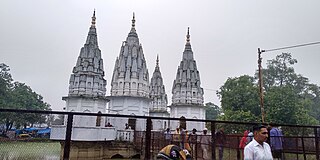
Etawah, also known as Ishtikapuri, is a city on the banks of Yamuna River in the state of Western Uttar Pradesh in India. It is the administrative headquarters of Etawah District. Etawah's population of 256,838 makes it the 180th most populous city in India. The city lies 300 km (190 mi) southeast of the national capital New Delhi, 230 km (140 mi) northwest of the state capital Lucknow, 120 km east of Agra and 140 km west of Kanpur. The city was an important centre for the Indian Rebellion of 1857. It is also the sangam or confluence of the Yamuna and Chambal rivers. It is the 26th most populous city in Uttar Pradesh.
Mainpuri is a city in Mainpuri district in the Indian state of Uttar Pradesh. It is the administrative headquarters of Mainpuri district and is situated to the north-east of Agra and is 270 km from New Delhi. Mainpuri is located in the Braj region, which holds special religious significance to Hindus as the homeland of Krishna.

Etah district is one of the districts of Uttar Pradesh, India, since 1854. Etah City is the district headquarters. Etah district is a part of Aligarh Division.

Firozabad district is one of the western districts of the Indian state of Uttar Pradesh, which has Firozabad city as its district headquarters. The district is a part of the Agra division.

Kannauj district is an administrative district of Uttar Pradesh state in northern India, along the river Ganges. The historic town of Kannauj, northwest of Kanpur, is the administrative center. The district was carved out of Farrukhabad district on 18 September 1997. The native dialect of this district is Kannauji.
Karhal is a town and Nagar Panchayat in Mainpuri district in the Indian state of Uttar Pradesh. It is also a tehsil that is subdivided into two blocks, Karhal and Barnahal. It is one of the Vidhan Sabha constituency of Uttar Pradesh.
Kishni is a town in Bhongaon tehsil of Mainpuri district in the Indian state of Uttar Pradesh. It is also the seat of a community development block. As of 2011, the town of Kishni has a population of 11,098, in 5,832 households.
Shikohabad is a city and a municipal board in the Firozabad district of the Indian state of Uttar Pradesh.
Aryapur Khera is the village. Mainpuri city is an administrative headquarters of this village. Mainpuri is located to the north-east of Agra.

Saifai is a large village and university town in the Etawah district of the Indian state of Uttar Pradesh. It is also a sub-division (Tehsil) and Block of the Etawah district. It is the birthplace of Mulayam Singh Yadav, the founding president of the Samajwadi Party, former Minister of Defence in India, and former Chief Minister of Uttar Pradesh.
Kishni is one of the 403 constituencies of the Uttar Pradesh Legislative Assembly, India. It is a part of the Mainpuri district and one of the five assembly constituencies in the Mainpuri Lok Sabha constituency. First election in this assembly constituency was held in 1962 after the "DPACO (1961)" was passed in 1961. After the "Delimitation of Parliamentary and Assembly Constituencies Order" was passed in 2008, the constituency was assigned identification number 109.

Karhal Assembly constituency is one of the 403 constituencies of the Uttar Pradesh Legislative Assembly, India. It is a part of the Mainpuri district and one of the five assembly constituencies in the Mainpuri Lok Sabha constituency. First election in this assembly constituency was held in 1957 after the "DPACO (1956)" was passed in 1956. After the "Delimitation of Parliamentary and Assembly Constituencies Order" was passed in 2008, the constituency was assigned identification number 110.
Dehuli, also spelled Dihuli, is a village in Barnahal block of Mainpuri district, Uttar Pradesh. Its first mention in historical sources is around the year 1420, during a rebellion against the Delhi Sultanate. As of 2011, Dehuli has a population of 3,517, in 584 households.
Patara is a village in Karhal block of Mainpuri district, Uttar Pradesh, India. As of 2011, it had a population of 9,430, in 1,544 households.
Kurra Jarawan is a village in Karhal block of Mainpuri district, Uttar Pradesh. The village technically encompasses some 25 separate hamlets, which are grouped together for administrative purposes. A market is held in the village twice per week. As of 2011, Kurra Jarawan has a total population of 9,014, in 1,568 households.
Saman is a large village in Kishni block of Mainpuri district, Uttar Pradesh. It is the site of the Saman Bird Sanctuary, a large wetland area designated as a protected Ramsar site since 2019. The village lands occupy a large area, and there are many distinct hamlets counted as part of its administrative jurisdiction. As of 2011, Saman had a total population of 14,522, in 2,382 households.
Jamlapur is a village in Kuraoli block of Mainpuri district, Uttar Pradesh. As of 2011, it had a population of 1,344, in 223 households.
Sakat Bewar is a village in Bewar block of Mainpuri district, Uttar Pradesh. As of 2011, it had a population of 3,736, in 636 households.
Dayantnagar Mata, also spelled Dayanatnagar Mata or Dayanatnagar Mota, is a village in Bewar block of Mainpuri district, Uttar Pradesh. As of 2011, it has a population of 1,657, in 271 households.
Madhan is a village in Ghiror block of Mainpuri district, Uttar Pradesh, India. It is located on the road from Ghiror to Kuraoli, where it crosses the Isan river. There is an old fort in the village. As of 2011, Madhan had a population of 8,099, in 1,266 households.








